Related Research Articles

Hornblende is a complex inosilicate series of minerals. It is not a recognized mineral in its own right, but the name is used as a general or field term, to refer to a dark amphibole. Hornblende minerals are common in igneous and metamorphic rocks.
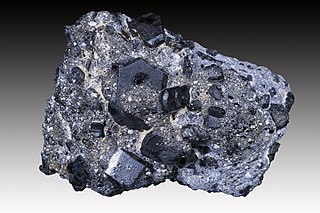
Augite, also known as Augurite, is a common rock-forming pyroxene mineral with formula (Ca,Na)(Mg,Fe,Al,Ti)(Si,Al)2O6. The crystals are monoclinic and prismatic. Augite has two prominent cleavages, meeting at angles near 90 degrees.

Rhodochrosite is a manganese carbonate mineral with chemical composition MnCO3. In its pure form (rare), it is typically a rose-red colour, but it can also be shades of pink to pale brown. It streaks white, and its Mohs hardness varies between 3.5 and 4.5. Its specific gravity is between 3.45 and 3.6. The crystal system of rhodochrosite is trigonal, with a lattice structure and cleavage in the carbonate rhombohedral system. The carbonate ions (CO2−
3) are arranged in a triangular planar configuration, and the manganese ions (Mn2–) are surrounded by six oxygen ions in an octahedral arrangement. The MnO6 octahedra and CO3 triangles are linked together to form a three-dimensional structure. Crystal twinning is often present. It can be confused with the manganese silicate rhodonite, but is distinctly softer. Rhodochrosite is formed by the oxidation of manganese ore, and is found in South Africa, China, and the Americas. It is one of the national symbols of Argentina.
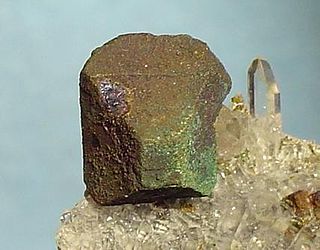
Bornite, also known as peacock ore, is a sulfide mineral with chemical composition Cu5FeS4 that crystallizes in the orthorhombic system (pseudo-cubic).

Cassiterite is a tin oxide mineral, SnO2. It is generally opaque, but it is translucent in thin crystals. Its luster and multiple crystal faces produce a desirable gem. Cassiterite was the chief tin ore throughout ancient history and remains the most important source of tin today.

Galena, also called lead glance, is the natural mineral form of lead(II) sulfide (PbS). It is the most important ore of lead and an important source of silver.
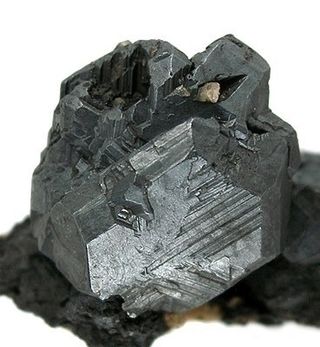
Chalcocite, copper(I) sulfide (Cu2S), is an important copper ore mineral. It is opaque and dark gray to black, with a metallic luster. It has a hardness of 2.5–3 on the Mohs scale. It is a sulfide with a monoclinic crystal system.

Chrysocolla ( KRIS-ə-KOL-ə) is a hydrous copper phyllosilicate mineral and mineraloid with the formula Cu
2 – xAl
x(H
2Si
2O
5)(OH)
4⋅nH
2O (x < 1) or (Cu, Al)
2H
2Si
2O
5(OH)
4⋅nH
2O).

Albite is a plagioclase feldspar mineral. It is the sodium endmember of the plagioclase solid solution series. It represents a plagioclase with less than 10% anorthite content. The pure albite endmember has the formula NaAlSi
3O
8. It is a tectosilicate. Its color is usually pure white, hence its name from Latin, albus. It is a common constituent in felsic rocks.

The mineral group tantalite [(Fe, Mn)Ta2O6] is the primary source of the chemical element tantalum, a corrosion (heat and acid) resistant metal. It is chemically similar to columbite, and the two are often grouped together as a semi-singular mineral called coltan or "columbite-tantalite" in many mineral guides. However, tantalite has a much greater specific gravity than columbite (8.0+ compared to columbite's 5.2). Iron-rich tantalite is the mineral tantalite-(Fe) or ferrotantalite and manganese-rich is tantalite-(Mn) or manganotantalite.

Lechatelierite is silica glass, amorphous SiO2, non-crystalline mineraloid. It is named for Henry Louis Le Chatelier.

Elbaite, a sodium, lithium, aluminium boro-silicate, with the chemical composition Na(Li1.5Al1.5)Al6Si6O18(BO3)3(OH)4, is a mineral species belonging to the six-member ring cyclosilicate tourmaline group.

Lithiophilite is a mineral containing the element lithium. It is lithium manganese(II) phosphate with chemical formula LiMnPO4. It occurs in pegmatites often associated with triphylite, the iron end member in a solid solution series. The mineral with intermediate composition is known as sicklerite and has the chemical formula Li(Mn,Fe)PO4). The name lithiophilite is derived from the Greek philos (φιλός) "friend", as lithiophilite is usually found with lithium.
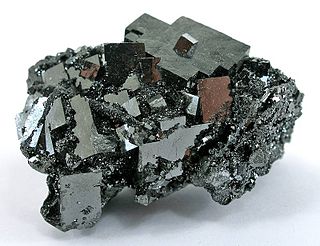
Bixbyite is a manganese iron oxide mineral with chemical formula: (Mn,Fe)2O3. The iron/manganese ratio is quite variable and many specimens have almost no iron. It is a metallic dark black with a Mohs hardness of 6.0 – 6.5. It is a somewhat rare mineral sought after by collectors as it typically forms euhedral isometric crystals exhibiting various cubes, octahedra, and dodecahedra.

Sugilite ( SOO-gə-lyte, -jee-) is a relatively rare pink to purple cyclosilicate mineral with the complex chemical formula KNa2(Fe, Mn, Al)2Li3Si12O30. Sugilite crystallizes in the hexagonal system with prismatic crystals. The crystals are rarely found and the form is usually massive. It has a Mohs hardness of 5.5–6.5 and a specific gravity of 2.75–2.80. It is mostly translucent. Sugilite was first described in 1944 by the Japanese petrologist Ken-ichi Sugi (1901–1948) for an occurrence on Iwagi Islet, Japan, where it is found in an aegirine syenite intrusive stock. It is found in a similar environment at Mont Saint-Hilaire, Quebec, Canada. In the Wessels mine in Northern Cape Province of South Africa, sugilite is mined from a strata-bound manganese deposit. It is also reported from Liguria and Tuscany, Italy; New South Wales, Australia and Madhya Pradesh, India.

Zabuyelite is the natural mineral form of lithium carbonate, with a formula Li2CO3. It was discovered in 1987 at Lake Zabuye, Tibet, after which it is named. It forms colorless vitreous monoclinic crystals.

Zirconolite is a mineral, calcium zirconium titanate; formula CaZrTi2O7. Some examples of the mineral may also contain thorium, uranium, cerium, niobium and iron; the presence of thorium or uranium would make the mineral radioactive. It is black or brown in color.
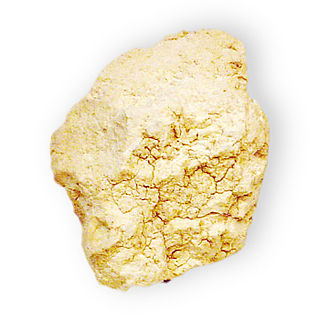
Hectorite is a rare soft, greasy, white clay mineral with a chemical formula of Na0.3(Mg,Li)3Si4O10(OH)2.
Faizievite is a very rare mineral with the formula K2Na(Ca6Na)Ti4Li6Si24O66F2. This triclinic mineral is chemically related to baratovite and katayamalite. Faizievite is a single-locality mineral, coming from the moraine of the Darai-Pioz glacier, Tien Shan Mountains, Tajikistan. Alkaline rocks of this site are famous for containing numerous rare minerals, often enriched in boron, caesium, lithium, titanium, rare earth elements, barium, and others.
References
- ↑ Warr, L.N. (2021). "IMA–CNMNC approved mineral symbols". Mineralogical Magazine. 85 (3): 291–320. Bibcode:2021MinM...85..291W. doi: 10.1180/mgm.2021.43 . S2CID 235729616.
- ↑ Xieite mineral data from Webmineral
- 1 2 3 Mindat.org